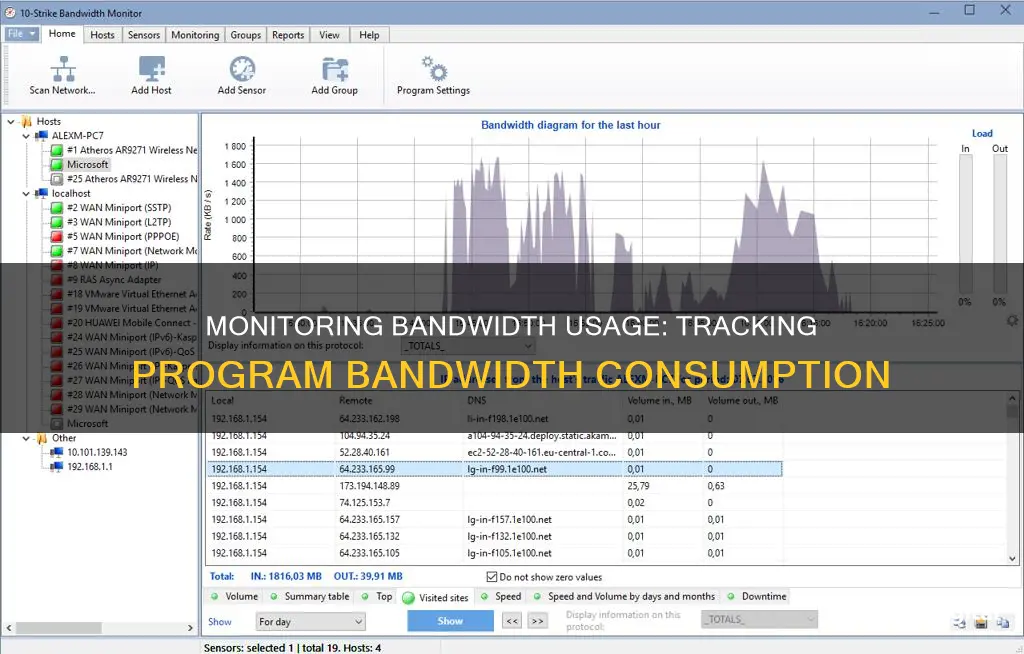
Bandwidth monitoring is a crucial practice for network administrators to ensure optimal network performance and security. It involves tracking available bandwidth on a local area network (LAN) or wide area network (WAN) and identifying bandwidth hogs, which could indicate network intrusion or other issues. By using bandwidth monitoring tools, administrators can gain real-time insights into network usage, manage bandwidth limits, and address performance problems proactively. These tools help identify applications or devices consuming excessive bandwidth and enable administrators to block non-business applications causing high traffic. Additionally, they assist in planning bandwidth provisioning, ensuring sufficient bandwidth levels for business needs.
| Characteristics | Values |
|---|---|
| Purpose | Monitor bandwidth usage to identify issues and ensure optimal performance |
| Data Collected | Bandwidth usage by specific applications or interfaces, traffic patterns, response times, uptime/downtime of devices |
| Alerts | Customizable alerts for excessive bandwidth usage, suspicious activity, or potential issues |
| Reports | Utilization thresholds, volume, speed, packet count, jitter, top conversations, IN/OUT network usage, device traffic over time, bandwidth usage forecasts |
| Tools | SolarWinds Observability Self-Hosted, SolarWinds Network Performance Monitor, ManageEngine NetFlow Analyzer, PRTG Network Monitor, NetWorx, BitMeter OS |
What You'll Learn

Identify bandwidth hogs
Bandwidth hogs are programs, users, or devices that consume excessive network bandwidth, leading to reduced network performance and potential delays in activities. To identify these hogs, you can utilize various tools and techniques:
Utilize Built-in Tools
If you use Windows 10, open the Settings app and search for "Data usage." This will provide an overview of your network status and allow you to see which apps have used the most bandwidth over the past 30 days. For macOS users, the "Network" tab in the Activity Monitor app provides a real-time view of data usage by apps.
Specialized Network Diagnostic Programs
Specialized software like Little Snitch (for Mac) and GlassWire (for Windows) can provide more detailed insights into bandwidth usage, although they may require some familiarity with networking jargon. These tools can help identify issues caused by legitimate software or malware that isn't coded to work well with others.
Network Traffic Analysis Tools
Network traffic analysis tools, such as ManageEngine NetFlow Analyzer, SolarWinds NetFlow Traffic Analyzer, and Paessler PRTG Bandwidth Monitor, offer advanced features to identify bandwidth hogs. These tools can track live traffic patterns, generate reports, and provide insights into which applications, sources, and destinations are consuming the most bandwidth.
Set Alerts for Excess Utilization
Configure alert notifications to receive emails or SMS when network usage exceeds set thresholds. This way, you can quickly identify and address potential bandwidth hogs before they cause significant issues.
Identify Top Talkers
Drill down into the bandwidth usage data to identify the top talkers, i.e., the applications or protocols consuming the most bandwidth. This information will help you pinpoint the specific programs or users causing congestion on your network.
Analyze Root Causes
Don't just focus on the symptoms; analyze the root causes of bandwidth hogs. Are there specific users, departments, or applications consistently consuming excessive bandwidth? This information will help you implement targeted solutions, such as redefining QoS policies or applying ACLs to manage network traffic effectively.
Beware: Your Boss May Monitor Your Internet Usage
You may want to see also

Monitor network traffic
Monitoring network traffic is essential for maintaining optimal network performance and security. Here are some detailed instructions on how to achieve this:
Choose a Suitable Bandwidth Monitoring Tool
Select a bandwidth monitoring tool that suits your specific needs. Examples include SolarWinds NetFlow Traffic Analyzer, ManageEngine NetFlow Analyzer, and PRTG Network Monitor. These tools provide real-time insights into bandwidth usage and help identify bandwidth hogs, allowing you to address any issues promptly.
Set Up and Configure the Tool
Install and set up the chosen bandwidth monitoring tool on your network. Ensure it covers all critical devices and interfaces. Configure the tool to collect relevant data, such as traffic volume, packet loss, latency, and jitter. Set up alerts to notify you of any significant changes or issues.
Analyze Bandwidth Usage Patterns
Use the monitoring tool to analyze bandwidth usage over time. Look for trends, spikes, or anomalies that may indicate potential issues or security threats. Identify applications or devices consuming excessive bandwidth and consider optimizing their usage or implementing traffic shaping strategies.
Utilize Reporting and Alerting Features
Take advantage of the reporting capabilities of the monitoring tool. Generate reports on bandwidth usage, traffic patterns, and network performance. Customize and schedule reports to gain insights into historical data and identify long-term trends. Set up alerts to receive notifications when specific thresholds are reached, such as high bandwidth usage or suspicious activity.
Implement Security Measures
Monitor for any suspicious or malicious network activity. Block bandwidth-heavy websites and scan for malware regularly. Prioritize critical applications using Quality of Service (QoS) to reserve bandwidth for them. Stay proactive in addressing potential security threats to protect sensitive data.
Optimize Bandwidth Usage
Analyze the data provided by the monitoring tool to optimize bandwidth usage. Identify areas where bandwidth can be conserved or reallocated. Implement measures such as blocking non-essential websites or reserving bandwidth for specific applications to ensure efficient usage.
Regularly Review and Adjust
Continuously review the insights and reports provided by the monitoring tool. Adjust your network configuration, security measures, and bandwidth allocation as needed to maintain optimal performance and security. Stay up-to-date with the latest updates and improvements to your chosen monitoring tool.
Monitoring Bandwidth Usage: Wireshark's Essential Guide
You may want to see also

Track bandwidth usage
Bandwidth monitoring is the practice of measuring available bandwidth on a local area network (LAN) or wide area network (WAN). It is important to monitor bandwidth usage to identify bandwidth hogs, which could be an indication of a network intrusion, and to ensure that your network is running optimally.
There are a variety of bandwidth monitoring tools available that can help you track bandwidth usage. These tools can provide real-time insights into usage across your network, allowing you to manage any bandwidth limits and identify issues.
SolarWinds NetFlow Traffic Analyzer
This tool offers full bandwidth monitoring and management features. It communicates with switches and routers through various communication protocols, including NetFlow, J-Flow, and IPFIX, enabling it to monitor a multi-vendor network. It provides comprehensive traffic analysis, link-specific views, and traffic shaping capabilities. It also includes alerting features to notify you of any issues.
ManageEngine NetFlow Analyzer
This tool scans your network and documents all switches and routers, noting each interface and its capacity. It provides real-time analysis, data collection, and alert notifications. It also offers long-term reporting capabilities, helping you to prepare for the future and address usage issues.
PRTG Network Monitor
This is a comprehensive bundle of monitoring tools for networks, servers, and applications. It includes traffic sampling sensors for traffic management and supports various protocols for comprehensive network monitoring. It provides real-time traffic visualization and helps identify overloaded network links.
Datadog Network Performance Monitoring
This cloud-based package tracks network traffic patterns and provides detailed traffic insights. It offers visual data representations, making it easy to comprehend traffic activity. It also includes performance alerts for proactive network management.
ManageEngine Bandwidth Monitoring Tool
This tool is part of the ManageEngine OpUtils package, which offers a suite of network management capabilities. It utilizes SNMP for efficient and reliable network monitoring and provides interface-level statistics. It enables focused monitoring and analysis of traffic on specific network links.
By using these tools and monitoring bandwidth usage, you can ensure optimal network performance, identify potential issues, and optimize bandwidth utilization.
Deltek's Internet Monitoring: What You Need to Know
You may want to see also

Monitor network performance
Network performance monitoring is the process of visualizing, monitoring, optimising, troubleshooting, and reporting on the health and availability of your network as experienced by your users.
Network Performance Monitoring (NPM) tools can utilize different types of telemetry, including device metrics, network flow data, and packet data.
Device Metrics
SNMP (Simple Network Management Protocol) is a widely used protocol for monitoring and managing network devices and their functions. SNMP is supported on a wide range of hardware, from routers and switches to endpoints like printers, scanners, and IoT devices. It provides critical information and diagnostics about network device and interface availability, bandwidth utilization, packet loss, latency, errors, discards, CPU, and memory.
Network Flow Data
Flow data is generated by network devices such as routers and switches. It provides information on who is communicating with whom, when, how much data was transferred, and how often. NetFlow, jFlow, and IPFIX are examples of flow data protocols. Monitoring and analyzing flow data helps obtain valuable insights about network users, peak usage times, and traffic patterns.
Packet Data
Packet capture is the process of passively copying and storing data packets crossing a specific point in a network for analysis. Packets help diagnose and solve network problems, such as troubleshooting detrimental network and application activities, identifying security threats, and understanding capacity issues.
Choosing a Network Bandwidth Monitoring Tool
When choosing a network bandwidth monitoring tool, consider the size and complexity of your network, the monitoring technologies supported by your hardware, and your budget. Some popular tools include:
- SolarWinds Observability Self-Hosted
- SolarWinds NetFlow Traffic Analyzer
- PRTG Network Monitor
- ManageEngine NetFlow Analyzer
- Datadog Network Performance Monitoring
- Ntopng
- Nagios
- Progress WhatsUp Gold
Colleges Monitoring Student Online Activity: Is Privacy Invasive?
You may want to see also

Optimise bandwidth usage
Bandwidth monitoring is the practice of measuring available bandwidth on a local area network (LAN) or wide area network (WAN). Optimising bandwidth usage is important to ensure that your network keeps up with customer and user expectations. Here are some ways to optimise bandwidth usage:
Shape Bandwidth Traffic
Quality of service (QoS) protocols optimise bandwidth usage by identifying important data packets. These packets receive a greater allocation of traffic resources, which ensures that important data flows between user and applications. Without QoS, bandwidth shape flattens instead of matching the specific needs of your business, potentially resulting in costly data centre bottlenecks.
Optimise Wide Area Network Traffic
Compression lessens the amount of data transferred over networks by reducing the size of files transferred. Data caching stores information frequently accessed on local servers and storage, reducing bandwidth requirement for WANs. Shaping traffic over WANs further improves optimisation.
Utilise Cloud Computing Solutions
One of the main benefits of cloud computing is outsourcing data-intensive functions to online platforms designed to provide the most efficient services available. Hybrid computing solutions provide the opportunity to blend local and cloud-based solutions, tailoring bandwidth usage specifically to your business. Local servers may host common functions accessed frequently, while cloud servers take care of issues such as data backup for disaster recovery or high-bandwidth functions.
Limit Access to Popular, Non-Business Sites
Sites like Facebook, YouTube, and Netflix eat bandwidth through digital video, a common medium across entertainment sites. These types of sites also distract employees and allow visitors to interact with media that has nothing to do with your business.
Schedule Use of Bandwidth
Business activity rises and falls according to predictable schedules. Many organisations operate on a nine-to-five schedule, while some experience peak activity in the evenings and weekends. Scheduling activities and bandwidth according to peaks and troughs in usage allows further optimisation of digital resources.
Other Tips
- Educate users on how to minimise content size before sending and when not to use the heaviest programs.
- Optimise your network for video consumption.
- When implementing VoIP, be mindful of the load it places on your network.
- Segment your network properly, either physically using intelligent switches or by using sub-nets.
Monitoring Home Electricity Usage: Data Collection Methods
You may want to see also
Frequently asked questions
A bandwidth monitor provides real-time updates on network traffic and bandwidth utilisation levels. It helps you understand if there is overutilisation of bandwidth or insufficient bandwidth availability, which could be the cause of slow network traffic.
Your Internet Service Provider (ISP) will give your business a certain amount of bandwidth. To check network bandwidth usage, you can manually examine bandwidth usage levels for individual devices on the network. However, this can be a time-consuming and unreliable task. An automated network bandwidth monitoring tool can help track traffic network usage and provide a real-time, centralised overview of bandwidth utilisation across a network.
Bandwidth monitoring can help address and prevent network slowdowns. It can also help identify non-business applications causing unnecessarily high levels of traffic, so you can block this activity and improve network speeds. It is also critical when planning bandwidth provisioning for your business network.
Devices that are heavily used and support multiple applications or types of applications typically use the most bandwidth. For example, virtualised devices, streaming video services, video chat and voice call services, and file-sharing applications.







